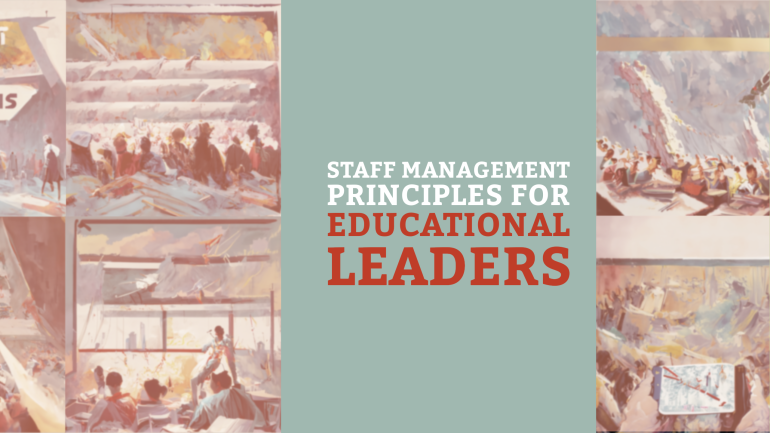Table of Contents
TL;DR: Essential Staff Management Principles for Educational Success
- Develop strong communication skills: Educational leaders need to effectively communicate expectations, provide feedback, and foster a collaborative environment within their teams.
- Lead by example: Demonstrate professionalism, integrity, and a strong work ethic to set a positive example for staff members to follow.
- Provide opportunities for professional growth: Support staff development through training, mentorship programs, and opportunities for advancement within the organization.
- Recognize and reward performance: Acknowledge and appreciate the achievements and contributions of staff members to boost morale and motivation within the team.
- Address performance issues promptly: Deal with performance concerns or conflicts in a timely and fair manner to maintain a positive work environment and uphold standards of excellence.
Most successful educational leaders understand that effective staff management is crucial for the overall well-being and success of a school. Implementing sound management principles can foster a positive work environment, improve staff morale, and ultimately enhance student achievement. In this post, we will discuss some important staff management principles that every educational leader should prioritize.
Understanding Educational Leadership
Even in the complex landscape of educational institutions, effective leadership plays a crucial role in shaping the direction and success of schools and organizations. Educational leaders are tasked with providing vision, direction, and support to create a conducive environment for learning and growth.
Defining Educational Leadership
On a fundamental level, educational leadership can be defined as the process of guiding and inspiring individuals within an educational setting to achieve common goals. It involves making strategic decisions, fostering collaboration, and nurturing a positive organizational culture that values innovation and continuous improvement. Education leaders are responsible for setting clear objectives, effectively communicating expectations, and empowering team members to realize their full potential.
The Role of Leaders in Schools and Institutions
Educational leaders serve as the driving force behind initiatives that drive student success, staff development, and institutional growth. They are advocates for equity and inclusivity, ensuring that all students have access to quality education and resources. These leaders are also responsible for building strong relationships with stakeholders, including teachers, staff, parents, and the community, to create a united front in pursuit of academic excellence.
Educational leaders are instrumental in creating a supportive and conducive learning environment that fosters both academic achievement and personal growth.
Principles of Staff Management
Promoting a Positive School Culture
Assuming the role of an educational leader comes with the responsibility of establishing and promoting a positive school culture. A positive school culture fosters a supportive environment where staff members feel valued, respected, and motivated to strive for excellence. Leaders can promote a positive school culture by emphasizing open communication, collaboration, and a shared vision for the school’s mission and values.
Establishing Clear Expectations and Goals
Management of staff starts with establishing clear expectations and goals to ensure that everyone is aligned towards a common purpose. By communicating clearly defined expectations and setting achievable goals, educational leaders empower their staff to work towards success. Clarity in expectations helps in reducing misunderstandings, conflicts, and enhances productivity within the school setting.
This principle emphasizes the importance of setting SMART goals (Specific, Measurable, Achievable, Relevant, Time-Bound) that are aligned with the school’s overall objectives. Educational leaders should provide regular feedback to staff members to ensure they are on track and offer support when needed. By setting clear expectations and goals, leaders create a roadmap for success and enable continuous improvement within the school community.
Communication Strategies for Leaders
Fostering Open and Effective Communication
To effectively lead a team, educational leaders must prioritize open and effective communication. Creating a culture of open communication where all staff members feel comfortable sharing their thoughts, ideas, and concerns is crucial for a healthy working environment. Leaders should encourage two-way communication, actively listen to their team members, and be approachable for discussions. Transparency in communication can help in building trust and fostering a sense of unity among the staff.
Utilizing Feedback for Growth and Development
Effective leaders understand the importance of utilizing feedback for the growth and development of their team. Feedback should be specific, constructive, and timely to be truly beneficial. Leaders should provide feedback regularly, highlighting both areas for improvement and strengths. By encouraging a growth mindset and creating opportunities for professional development based on feedback, leaders can help their staff reach their full potential.
Effective utilization of feedback can lead to improved performance, increased motivation, and enhanced job satisfaction among staff members. It also demonstrates that leaders are invested in the growth and success of their team.
Talent Acquisition and Retention
After establishing a vision for the educational institution, the next critical task for educational leaders is talent acquisition and retention. The success of any educational organization heavily depends on the quality of its staff. To ensure the recruitment of high-quality educators, leaders must develop a strategic approach to recruiting and selecting educational staff.
Recruiting and Selecting Educational Staff
Retention strategies should focus on attracting top talent through targeted recruitment efforts, utilizing networks and partnerships within the education community to identify potential candidates. A thorough selection process that includes interviews, reference checks, and performance assessments is imperative to identify candidates who align with the institution’s values, mission, and goals. By investing time and resources in the recruitment and selection process, educational leaders can secure a strong foundation of educators who will drive the institution towards success.
Strategies for Retaining High-Quality Educators
Talent retention is a key factor in maintaining a high-performing educational institution. Educational leaders should implement strategies for retaining high-quality educators that focus on professional development opportunities, competitive compensation packages, and a positive work culture. Providing ongoing support, feedback, and recognition to educators can significantly increase job satisfaction and engagement, ultimately leading to higher retention rates and improved student outcomes.
Development and Training Opportunities
Encouraging Continuous Professional Development
The cultivation of a culture that prioritizes continuous professional development is important for the growth and success of educational staff. All educational leaders should recognize the importance of providing teachers and staff with opportunities to enhance their skills and knowledge. By investing in training programs, workshops, and seminars, all staff can stay up-to-date with the latest industry trends and best practices.
Leadership Development for Building Future Leaders
The development of future leaders within an educational institution is crucial for its long-term sustainability and success. An effective leadership development program can identify individuals with leadership potential and provide them with the necessary tools and training to excel in leadership roles. By mentoring and coaching aspiring leaders, this program can help create a pipeline of talent that ensures continuity and growth within the organization.
Leadership development not only benefits the individuals involved, but also the organization as a whole. It fosters a culture of leadership excellence, empowers staff members to take on challenging roles, and ultimately contributes to the overall improvement of the educational institution.
Performance Evaluation Techniques
Designing Effective Evaluation Systems
Not all performance evaluation techniques are created equal. Educational leaders must carefully design evaluation systems that are tailored to their specific school environment and goals. A one-size-fits-all approach will not yield accurate results or effectively drive performance improvement. By incorporating a mix of quantitative and qualitative measures into the evaluation process, leaders can obtain a comprehensive view of staff performance.
Addressing Performance Issues and Providing Support
Designing an effective evaluation system is vital, but so is the ability to address performance issues and provide support to staff members. Educational leaders must possess the skills and knowledge to recognize and address performance problems quickly and effectively. This may involve providing additional training, mentorship, or resources to help struggling staff improve their performance.
The support provided should be tailored to each individual’s needs and may require ongoing communication and follow-up to ensure sustained improvement. It’s crucial for leaders to create a positive and supportive environment where staff feel empowered to address their weaknesses and grow professionally.
Navigating Challenges in Staff Management
Despite the best efforts of educational leaders, managing a diverse staff can present various challenges in any educational institution. These challenges may range from conflicts among team members to navigating through changing educational landscapes. Effective leadership requires the ability to address and resolve these challenges promptly and efficiently.
Conflict Resolution and Mediation
An integral part of staff management is the ability to handle conflicts that may arise among team members. Conflict resolution and mediation skills are crucial for maintaining a harmonious work environment. Leaders should act as neutral mediators, listening to all parties involved and guiding them towards a mutually beneficial resolution.
Adapting to Changing Educational Landscapes
An educational leader must be adept at adapting to the ever-evolving educational landscapes. These changes may include technological advancements, shifts in teaching methodologies, or new curriculum standards. Being proactive and staying abreast of these changes is important in ensuring the school remains competitive and provides quality education.
With the rise of online learning and remote teaching, educational leaders must also consider the impact of these changes on staff management. Implementing professional development opportunities to equip staff with the necessary skills for online teaching can help in the smooth transition to a more digitized educational landscape.
Promoting Diversity and Inclusivity
Building a Diverse Educational Workforce
Inclusivity: To cultivate a truly inclusive educational environment, it is important for educational leaders to focus on building a diverse workforce. Encouraging diversity in hiring practices, considering factors such as ethnicity, race, gender, sexual orientation, and background, can lead to a richer and more creative staff team.
Cultivating an Inclusive Environment for Staff and Students
Inclusivity: Fostering an inclusive environment for both staff and students is paramount for educational leaders. This involves promoting tolerance, respect, and understanding among all members of the educational community. By embracing diversity and creating space for open dialogue, leaders can nurture a culture where everyone feels valued and empowered.
Environment: It is crucial for school leaders to actively support and implement policies that promote inclusivity and foster a sense of belonging among staff and students. Providing ongoing training on cultural competency and creating platforms for sharing diverse perspectives can help bridge any gaps and create a more cohesive community within the educational setting.
Legal and Ethical Considerations in Staff Management
Understanding Employment Laws and Regulations
Ethical educational leaders must have a solid grasp of employment laws and regulations to create a fair and compliant work environment for their staff. Laws such as the Fair Labor Standards Act, Title VII of the Civil Rights Act, and the Family and Medical Leave Act govern various aspects of employment, including wages, discrimination, and leave entitlements. It is crucial for educational leaders to stay updated on these laws to avoid legal issues and ensure the rights and well-being of their staff.
Upholding Ethical Standards in Educational Leadership
Any educational leader must uphold ethical standards to maintain trust and respect within the school community. This involves demonstrating honesty, integrity, and transparency in decision-making processes. Educational leaders should also prioritize the well-being and development of their staff members, fostering a positive work culture that values diversity and inclusivity. By setting a strong example of ethical conduct, leaders can inspire their teams to uphold similar values and promote a harmonious work environment.
Employment practices that prioritize fairness, respect, and professionalism not only create a positive work environment but also contribute to the overall success of the educational institution. Educational leaders play a crucial role in setting the tone for ethical behavior and compliance with legal requirements, ensuring that staff members feel valued, supported, and motivated to perform their best.
Utilizing Technology and Innovation
Digital Tools for Staff Management and Communication
Communication is key in educational leadership, and digital tools can make this process more efficient and effective. Utilizing platforms such as communication apps, project management tools, and video conferencing software can streamline communication among staff members, allowing for quick dissemination of information, collaboration on projects, and fostering a sense of community within the organization. These tools also enable leaders to provide timely feedback, updates, and support to their staff, leading to improved overall performance.
Embracing Innovations in Education
The field of education is constantly evolving, and it is crucial for educational leaders to stay ahead of the curve by embracing innovations in the sector. This includes adopting new teaching methodologies, integrating educational technologies into the curriculum, and promoting a culture of continuous learning and professional development among staff members. By embracing innovations in education, leaders can enhance the quality of teaching and learning in their institution, better prepare students for the future, and maintain a competitive edge in the education landscape.
Plus, by staying abreast of the latest trends and developments in the field of education, leaders can anticipate upcoming challenges and opportunities, allowing them to make informed decisions that will benefit their staff and students in the long run.
Financial Management and Resource Allocation
Budgeting for Staffing and Professional Development
Management of finances and resources is crucial for educational leaders to ensure the smooth operation of their institutions. As far as budgeting for staffing and professional development, it is imperative to allocate funds efficiently to support the growth and development of staff members. By setting aside a dedicated budget for staffing, schools can attract and retain high-quality educators, provide competitive salaries, and offer opportunities for professional growth.
Ensuring Fair and Equitable Resource Distribution
For educational leaders, ensuring fair and equitable resource distribution is paramount to creating a positive work environment and fostering a culture of trust among staff members. This involves making strategic decisions on how to allocate resources such as funding, materials, and support services to different departments and individuals based on their needs and performance. Ensuring that resources are distributed fairly and equitably can help prevent conflicts, promote teamwork, and ultimately enhance the overall effectiveness of the organization.
Collaborating with Stakeholders
Many educational leaders understand the critical role that stakeholders play in the success of a school. By collaborating with parents, community members, and other key stakeholders, leaders can create a supportive and inclusive environment for students to thrive.
Engaging with Parents and the Community
Collaborating with parents and the community is imperative for building a strong school culture. When parents are actively involved in their child’s education, students tend to perform better academically and have improved behavior. It is important for educational leaders to communicate openly with parents, listen to their concerns, and involve them in decision-making processes. By fostering strong relationships with parents and the community, leaders can create a sense of trust and partnership that benefits the entire school community.
Building Partnerships for School Improvement
Community partnerships are crucial for driving school improvement initiatives. By collaborating with local businesses, nonprofits, and other organizations, educational leaders can access additional resources, expertise, and support to enhance the learning environment. It is important for leaders to identify shared goals and establish clear communication channels to effectively work together towards improving student outcomes.
Measuring Impact and Success
Despite the complexities involved in managing a school staff, educational leaders must prioritize measuring impact and success to ensure the institution’s continuous growth and development. This involves setting clear benchmarks for school performance and analyzing data to inform staff management decisions.
Setting Benchmarks for School Performance
Impact Setting benchmarks for school performance is crucial for educational leaders to track the progress and success of their staff and students. By establishing specific goals and standards, leaders can create a roadmap for their school’s advancement and hold themselves and their staff accountable for achieving desired outcomes. These benchmarks can include academic achievements, student attendance rates, teacher retention rates, and overall school climate indicators.
Analyzing Data to Inform Staff Management Decisions
Staff Analyzing data to inform staff management decisions is a critical component of effective educational leadership. By examining key performance metrics and trends, leaders can identify areas of strength and areas needing improvement within their staff members. This data-driven approach enables leaders to make informed decisions on professional development opportunities, personnel assignments, and resource allocations to support the growth and success of their staff.
The ability to leverage data effectively can lead to significant improvements in staff performance, job satisfaction, and overall school effectiveness. Educational leaders who prioritize data analysis and evidence-based decision-making are better equipped to address challenges, foster a culture of continuous improvement, and ultimately drive positive outcomes for their staff and students.
Final Words
With these considerations in mind, it is evident that effective staff management is crucial for the success of educational leaders. By understanding the principles outlined in this guide and implementing strategies to support and develop staff, leaders can create a positive and productive work environment that ultimately benefits both the staff and the students. It is necessary for educational leaders to prioritize staff management practices in order to foster a culture of collaboration, growth, and success within their organization.
FAQ
Q: What are staff management principles for educational leaders?
A: Staff management principles for educational leaders are strategies and approaches that help school administrators effectively lead and communicate with their staff, cultivate a positive work environment, and achieve organizational goals.
Q: Why are staff management principles important for educational leaders?
A: Staff management principles are important for educational leaders because they help in fostering a culture of collaboration, trust, and professional growth among staff members. Effective staff management also leads to improved job satisfaction, productivity, and student outcomes.
Q: What are some key principles of staff management for educational leaders?
A: Key principles of staff management for educational leaders include establishing clear expectations, providing regular feedback and support, promoting professional development, fostering open communication, recognizing and rewarding achievements, and addressing conflicts promptly and effectively.
Q: How can educational leaders implement staff management principles effectively?
A: Educational leaders can implement staff management principles effectively by leading by example, building strong relationships with staff members, empowering and delegating responsibilities, promoting a positive organizational culture, addressing individual needs and concerns, and continuously seeking feedback for improvement.
What are the benefits of applying staff management principles in educational settings?
A: Applying staff management principles in educational settings can lead to increased staff morale, job satisfaction, retention rates, and ultimately, improved student achievement. It also helps in creating a cohesive and motivated team that works towards common goals and objectives.




